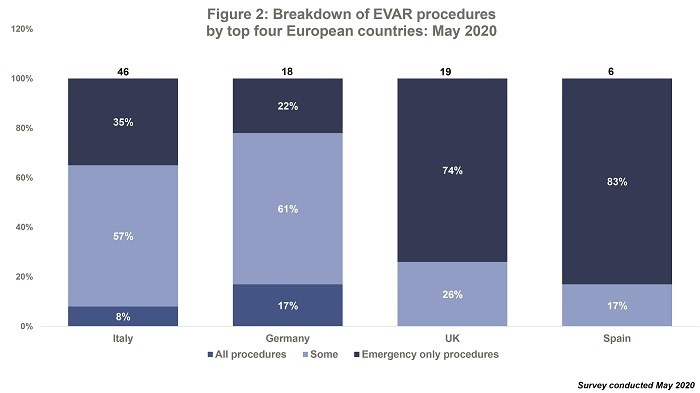
A new survey, conducted in May 2020, shows that about 65% of physicians in Western Europe believe their centres could be performing their normal level of endovascular aneurysm repair (EVAR) procedures within three months of COVID-related restrictions being lifted. Similar findings were seen for elective endovascular thoracoabdominal procedures (chimney EVAR/fenestrated EVAR) and elective thoracic endovascular aortic repair (TEVAR) procedures.
BIBA MedTech Insights polled physicians at 238 centres across the globe about how the COVID-19 pandemic has affected clinical practice at their centre. More than half of respondents were vascular surgeons, with the rest ranging from interventional radiologists to angiologists. Furthermore, 46% of respondents came from the top four European countries: Italy, Germany, the UK, and Spain. Therefore, this article reviews the key Western European findings from the survey.

Overall, in Western Europe, the survey showed a trend for centres to have seen at least seen some reduction in endovascular aortic (thoracic, thoracoabdominal, and abdominal) procedures, with only a few respondents saying that their centres were continuing to perform all elective and emergency procedures. However, the proportion of centres only performing emergency procedures did depend on the type of procedure or the country. For example, 74% of UK centres were only performing emergency EVAR procedures, but only 22% of German centres were (see Figure 2). Furthermore, of the UK centres that were still performing at least some elective EVAR procedures, the tendency was for them to have seen a more than 25% reduction in elective procedures.

Looking to the future, the survey asked respondents how soon they thought their centre would be back to performing their usual level of elective procedures. The answers, again, differed depending on the type of procedure. But, the general suggestion was that it would take up to three months for procedures to “return to normal” (assuming all COVID-19 restrictions on performing elective procedures are lifted).
Referring to EVAR, in Western Europe, 30% of respondents estimated that their centre could be back to performing their normal level of elective procedures within one month and 35% guessed between one and three months (65% overall). The majority of respondents also believed that they could “return to normal” in terms of elective TEVAR and Chimney/Fenestrated EVAR procedures within three months. Again, there was great variation among different countries. Only 5% of UK respondents thought that their centre could return to their normal level of EVAR procedures by June (when asked in May) compared with 56% of German respondents. However, 47% of UK physicians estimated that they could get back to normal between one and three months. See Figure 3.

In terms of the measures needed to “clear the backlog” of elective procedures, in the survey overall, increased operating days, adjusted working practices (such as more frequently using a minimally invasive approach), and increased operating hours were the most common answers. However, of note, 10% felt no extra measures would be necessary. See Figure 4.













